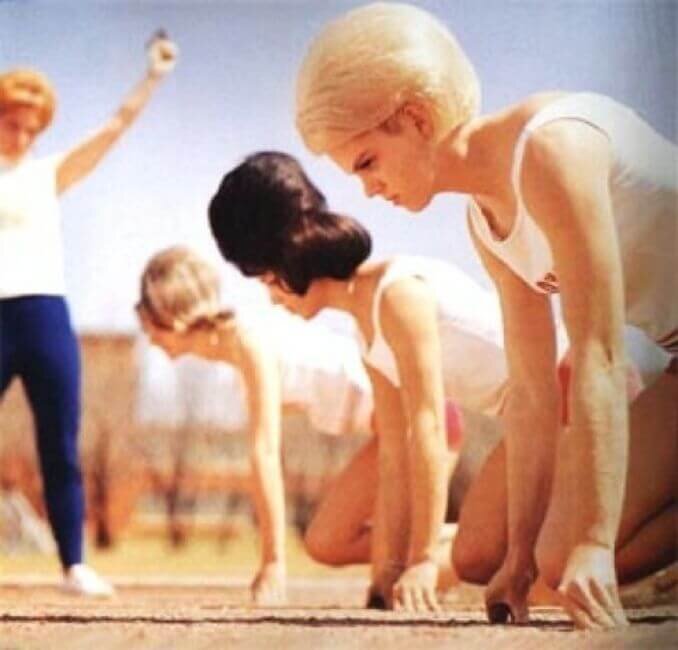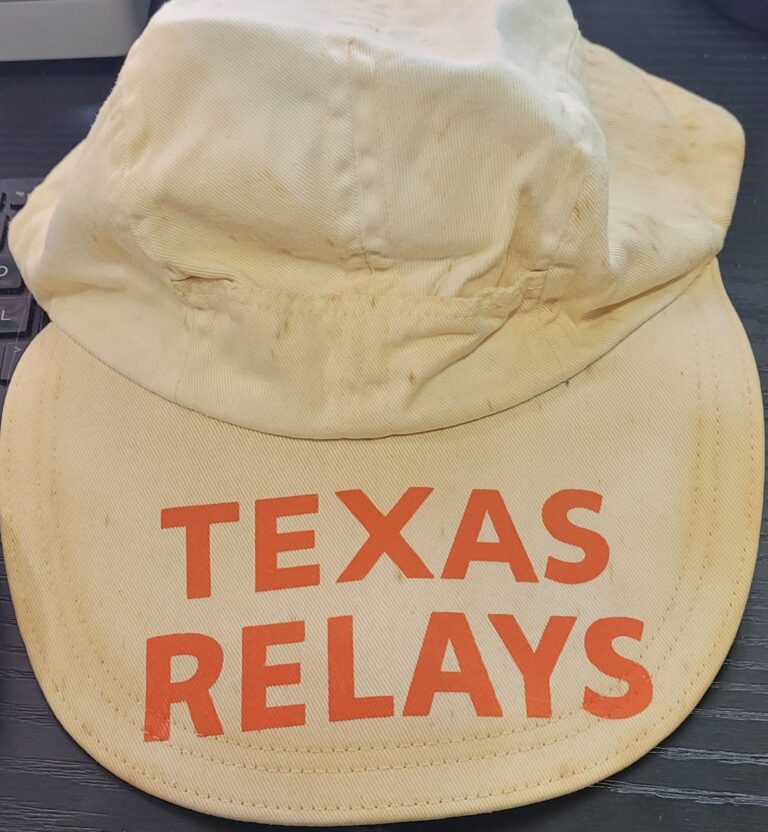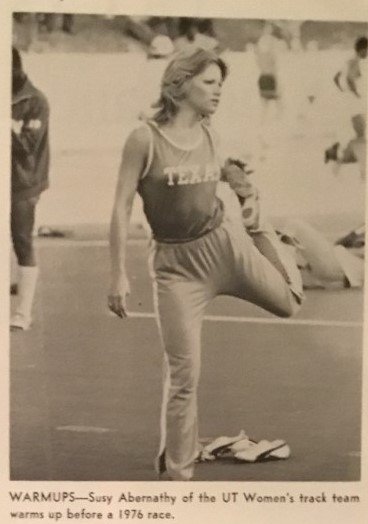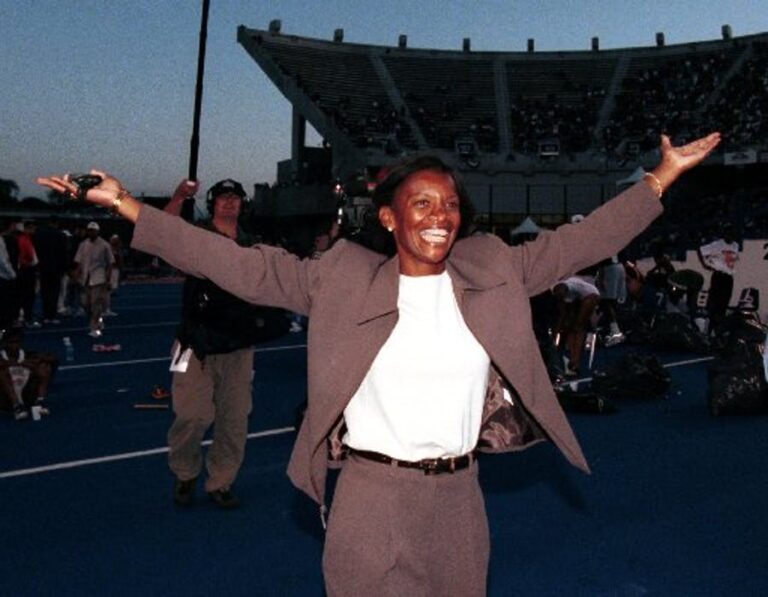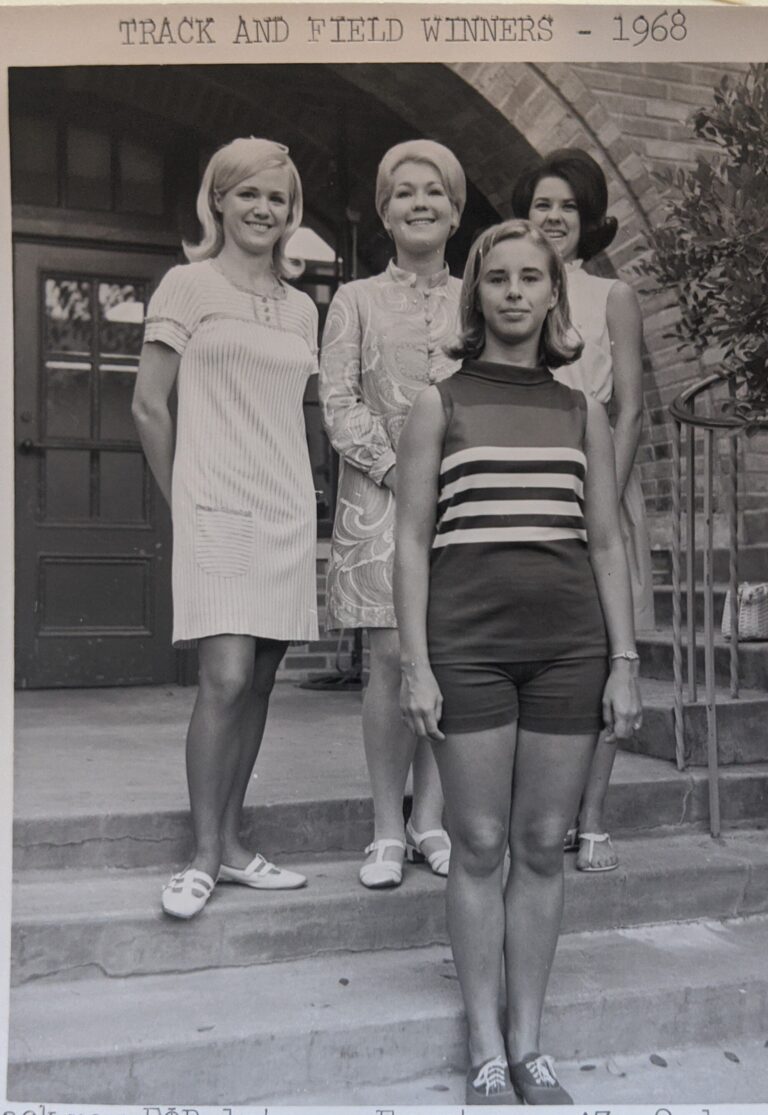1964- Bouffant Belles
Article by Gilbert Rogin.
Part of an article titled FLAMIN’ MAMIE’S BOUFFANT BELLES is below
A BEAUTY-MINDED TEXAN PIONEERS A NEW GLAMOROUS LOOK IN WOMEN’S TRACK
Early one-morning last month, when nothing was stirring in Abilene, Texas but the reels of Muzak tape in a storefront on North Fourth Street, Mrs. Margaret Ellison put her gold starting blocks and red-white-and-blue batons in the trunk of her car and set out for Austin. A can of Rayette’s The Young Set hair spray rolled about on the floor, a javelin rattled against the top of the dash, and blaring forth from the radio were, or so said one of the three girls in back, “the Imitation Beatles.” She added disarmingly, “Did you know England just declared war on the United States? Lady Bird ate a Beatle.”
Mrs. Ellison, who is known by her passengers (to her face) as Miz El’son or (behind her back) as Flamin’ Mamie or Ma Kettle, is a 46-year-old divorcée who wears her tinted strawberry-blonde hair in what she calls a “chignon rat.” Mrs. Ellison’s interest is the Texas Track Club (see cover), the best of a handful of all-girl track clubs in Texas. Mrs. Ellison is its coach, and she will tell you that her girls are coming along “real well.”
The Texas Track Club is celebrated on two counts—its athletic achievements and the uncommon beauty of its girls, who compete in dazzling uniforms, elaborate makeup and majestic hairdos. These hairdos, which are either bouffant or flip if at all possible, may not be aerodynamically sound and maybe “out” east of the Hudson, but they are an unqualified sensation at a track meet. “They are our trademark,” says Jeanne Ellison, the coach’s 16-year-old daughter. “Bouffant is easier to run in because the wind doesn’t blow your hair in your face.”
In one sense, the Texas Track Club has done more to promote women’s track in the U.S. than if its members had, say, won the national AAU championships. (In fact, they finished 12th last year, with a third in the 440-yard relay and the 220-yard low hurdles and a sixth in the 220-yard dash.) After the age of 10, American girls generally lose interest in running—it is unbecoming and too far out. And American boys generally lose interest in the few girls who take up the sport, the popular belief being that they look like Olive Oyl or Tugboat Annie. The Texas Track Club, however, has shown that you can be beautiful and still run the 100 in 10.9. Because of this delightful anomaly, its members have been a hit—and spread the gospel—at such topflight meets as the Los Angeles, Albuquerque and Dallas Invitationals. And it is not at all unlikely that a couple of Mrs. Ellison’s girls will make the U.S. Olympic team.
Diane Reyes
“I’m trying to change the stereotyped image of the track girl,” says Mrs. Ellison. “Every year we have a good-looking team and good-looking uniforms—none of those bags. I prefer pretty girls. I insist that they wear makeup. We all go to the beauty shop before each meet, so we can get beautiful and get our minds off the meet.
“Track is hard to give up,” says Paula. “You learn new things, meet people. People satisfy me so much. If I don’t get out and run some each day, I feel like I’ve committed a sin. I’m in top shape, but in bad condition.” Indeed, Paula does real well by her white, sleeveless running shirt that has TEXAS emblazoned in big red letters across the front. “Mine fits tight,” she says. “A lot of boys tease me, call me Miss Texas. I’m all Texas. I shouldn’t talk so much about myself, but my life’s been so interesting.”
Sue Schexnayder, who was known as Swift Sue in high school, is 19 and one of eight children. She lives in Port Arthur and has a partial athletic scholarship at Odessa Junior College, where she and a solitary boy comprise the track team. Like Janis, Sue has done the 100 in 10.9. Sue’s workouts include four to six repeat 330s every other day, three to five repeat 60s, and 150s and 220s—all of which leads Mrs. Ellison to the dour observation that her college coach “is killing her.”
Carvelynne Leonard also has natural-curly hair, but Mrs. Ellison says, “She wears it long and plain. Paula’s going to fix it for her.” Carvelynne (her father expected a boy, whom he was going to name Carver) comes from Mont Belvieu, and is an all-district basketball player. Carvelynne’s father, a pumper for the Sun Oil Company, supervises and fosters his daughter’s track career. Carvelynne has been running competitively since she was 6, and was twice a national champion in the Junior Olympics. “The house wouldn’t be the same if I wasn’t running,” she says. “My dad, everyone expects me to.”
In 1961 Mrs. Ellison founded the Texas Track Club around her older daughter, Pat—now 21 and retired from competition—who had broken the 75-yard-dash record in the Junior Olympics. “It started out as kind of a dream,” Mrs. Ellison says, “and now we’ve had six different uniforms, I have a feeder club of 10 to 20 younger kids, the Abilene Track Club,
Louanne Lambert and Sherri Tater
“I’ve gotten tremendous satisfaction and enjoyment out of educating the girls socially, building their bodies, and helping them, and, as old as I am, I like the recognition and the glamour, too. Of course, each year I think maybe I won’t put as much into it. Last year I spent $3,000 of my own money on the club, and I’m always running around trying to get sponsors. When we went to Los Angeles, for instance, our trip was paid for by the Optimist Club of Abilene, the Arvin Norwood Drilling Company of Midland, and the Pool Well Servicing Company of San Angelo.
“I think I’ve helped pioneer women’s track in Texas, and given the girls and myself something better to do than drive around drinking Cokes. Before I organized the Texas Track Club nothing interested me. I never belonged to a bridge club. You see yourself in the girls. It lights a flame.”
“I’ve found that girls lose interest in track, don’t keep coming out regularly, if you don’t make a game of it,” says Mrs. Ellison. “That’s why we have different uniforms every year and go in for makeup and hairdos. It’s just like giving candy to kids—you have to keep them entertained. And you’ve got to get them young. But if you ever get that little blue ribbon into their hands….
1974 Jester women track participants
“I do think, however, that a man can coach girls better than a woman, for the simple reason that girls will listen to a man, they have more confidence in him, and a woman likes to show off for a man. But most men are too busy to understand women. They just say, put on a white blouse and shorts and come out. For instance, on my workout schedules, I always put down ‘No Talking.’ Girls are always yakking, ‘I went out with so-and-so.’ I don’t want to hear them talking personal problems. I keep saying girls are different. You can’t train them like boys, they get emotionally upset. You have to know their moods and recognize what these moods mean.”
Mrs. Ellison got the chance to put her theories into practice last year when she was selected to coach the women’s team in the dual meets with Russia, Poland, Germany and England. “I was in a state of shock,” she says. “Lord, I was hysterical.” The trip began disastrously. In Moscow, the girls performed way below expectations, and newspaper stories told how they broke training and carried on. The reports, Mrs. Ellison contends, were exaggerated. As the European trip progressed, the girls’ behavior and performances improved markedly. Mrs. Ellison says the girls told her in England that they were sorry they had given her such a hard time. “Two of the girls gave me presents,” she says. “I cried. It proved to me, however, that I can handle girls.”
The trip also gave Mrs. Ellison an opportunity to buy a form-fitting German uniform, which she had copied for the Texas Track Club by the Fab-Knit Division of Holt’s Sporting Goods in Waco, a fact that is boldly embroidered on the sweat-suit tops. “I wish I could design the stuff for the U.S. Olympic team,” Mrs. Ellison says. “Whoever picks them doesn’t know enough about style today. The uniforms are baggy, like the boys’. And someone ought to design a dress for the banquets the girls have to attend after every international meet. If a girl has nothing to wear she feels left out, and that creates problems. The traveling dresses aren’t too bad, but they have no style.” The Texas Track Club’s traveling uniforms are royal blue shifts that are decorated with a patch depicting the flag of Texas. “When we go to hotels they must wear the dresses,” says Mrs. Ellison. “They are permitted to wear slims in motels.”
As Mrs. Ellison drove south to Austin, the cactus, mesquite, and jackrabbit country gave way to more fertile farmland, and a sign proclaimed “Sure Fresh Eggs.” Sue was reading a history assignment in The American Spirit, and Mrs. Ellison was fiddling with the radio dial.
“This is the time when all the personalities come out,” said Mrs. Ellison. “You know, no one ever explained to me that you had to go to college to become a coach. Everything I’ve learned has been from books, talking and observation. Sometimes the men coaches make fun of me. They say you’re not a coach, you’re a promoter. Maybe I’m not a coach, but maybe I’m out to prove to these men who are so learned that I can do it. It will give me a lot of satisfaction to prove that it doesn’t take years of experience and education to become a successful coach. I’ve been coaching for only five years and I was the coach of the U.S. team that went to Russia. It’s a laugh in a way.
“Did you know that Babe Didrikson was the only girl from Texas that ever made the Olympic track team? I want Janis to make it and Sue and Dora…. Then someday I’d like to get me a summer track camp by a river and make Flamin’ Mamie a little money.” The story of Babe is at the link below
THE END OF ARTICLE ABOUT FLAMIN’ MAMIE’S BOUFFANT BELLES AND BEYOND
